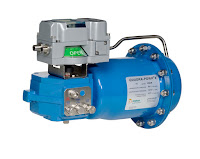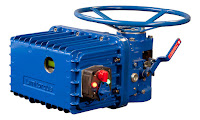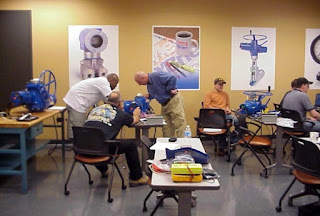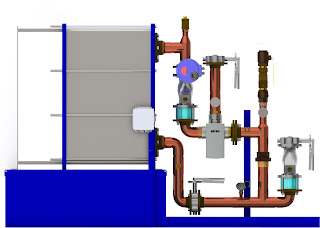With decades of expertise in rack and pinion and scotch-yoke actuators, as well as electric quarter-turn and linear actuators, Mead O'Brien has the experience and facilities to deliver a well engineered automated valve package. Visit www.meadobrien.com.
Providing problem solving and educational information for topics related to industrial steam, hot water systems, industrial valves, valve automation, HVAC, and process automation. Have a question? Give us a call at (800) 892-2769 | www.meadobrien.com
Industrial Valve Automation, Service and Repair
From quarter-turn ball, butterfly, or plug valves, to linear gate and globe valves, Mead O'Brien can handle the most challenging actuation design. Options and accessories such as valve communications, limit switches, fail-safe devices, and solenoid valves are no problem.
With decades of expertise in rack and pinion and scotch-yoke actuators, as well as electric quarter-turn and linear actuators, Mead O'Brien has the experience and facilities to deliver a well engineered automated valve package. Visit www.meadobrien.com.
With decades of expertise in rack and pinion and scotch-yoke actuators, as well as electric quarter-turn and linear actuators, Mead O'Brien has the experience and facilities to deliver a well engineered automated valve package. Visit www.meadobrien.com.
Understanding Industrial Valve Actuators
 |
| Automated Pneumatic Ball Valve (Jamesbury) |
Thanks to actuators, multiple valves can be controlled in a process system in a coordinated fashion; imagine if, in a large industrial environment, engineers had to physically adjust every valve via a hand wheel or lever! While that manual arrangement may create jobs, it is, unfortunately, completely impractical from a logistical and economic perspective. Actuators enable automation to be applied to valve operation.
 |
| Pneumatic actuator (Jamesbury Quadra-Powr) |
Pneumatic actuators utilize air pressure as the motive force which changes the position of a valve. Pressurized-liquid reliant devices are known as hydraulic actuators. Electric actuators, either motor driven or solenoid operated, rely on electric power to drive the valve trim into position. With controllers constantly monitoring a process, evaluating inputs, changes in valve position can be remotely controlled to provide the needed response to maintain the desired process condition.
Manual operation and regulation of valves is becoming less prevalent as automation continues to gain traction throughout every industry. Valve actuators serve as the interface between the control intelligence and the physical movement of the valve. The timeliness and automation advantages of the valve actuators also serve as an immense help in risk mitigation, where, as long as the system is functioning correctly, critical calamities in either environmental conditions or to a facility can be pre-empted and quickly prevented. Generally speaking, manual actuators rely on hand operation of levers, gears, or wheels, but valves which are frequently changed (or which exist in remote areas) benefit from an automatic actuator with an external power source for a myriad of practical reasons, most pressingly being located in an area mostly impractical for manual operation or complicated by hazardous conditions.
 |
| Electric Actuator (Limitorque) |
Thanks to their versatility and stratified uses, actuators serve as industrial keystones to, arguably, one of the most important control elements of industries around the world. Just as industries are the backbones of societies, valves are key building blocks to industrial processes, with actuators as an invaluable device ensuring both safe and precise operation.
Intelligent Transmitters Help Coal Plant Reduce Costs and Improve Performance
Effective, profitable power plant operation requires managing capital-expense turbine, boiler, and combustion equipment, along with many other assets that must be precisely balanced. Reliable readings of pressure, temperature, and other process variables are critical to success.
While analog transmitters are known for accuracy and reliability, maintenance costs increase with age, and flexibility for performance improvement is limited. To reduce long-term operating costs and maintain quality service to more than 300,000 customers, a Michigan power utility launched a program to replace its aging analog transmitters with modern digital models.
The utility uses transmitters for draft indications on the boiler and pulverized mill area. They read pressure on the boiler and the turbine as well as combustion and steam heating equipment. Some of the instruments send data to a centralized distributed control system (DCS), which manages the set points that control the sensitive interactions. Other instruments simply indicate various pressure states to operators and maintenance technicians.
When this power utility implemented its first DCS, all transmitters were analog. At the time, mixing and matching multiple brands of analog sensors was difficult, and in some cases impossible, due to proprietary mounting configurations. Managers at this Michigan power plant wanted to be certain that they selected a digital sensor that would not lock them into a single vendor.
To learn how this power company came up with a the solution and to learn the results, read the complete document below. For any process instrument requirement, visit Mead O'Brien at www.meadobrien.com or call (800) 892-2769.
While analog transmitters are known for accuracy and reliability, maintenance costs increase with age, and flexibility for performance improvement is limited. To reduce long-term operating costs and maintain quality service to more than 300,000 customers, a Michigan power utility launched a program to replace its aging analog transmitters with modern digital models.
The utility uses transmitters for draft indications on the boiler and pulverized mill area. They read pressure on the boiler and the turbine as well as combustion and steam heating equipment. Some of the instruments send data to a centralized distributed control system (DCS), which manages the set points that control the sensitive interactions. Other instruments simply indicate various pressure states to operators and maintenance technicians.
When this power utility implemented its first DCS, all transmitters were analog. At the time, mixing and matching multiple brands of analog sensors was difficult, and in some cases impossible, due to proprietary mounting configurations. Managers at this Michigan power plant wanted to be certain that they selected a digital sensor that would not lock them into a single vendor.
Selecting the Right Valve Automation Partner for the Power Industry
 |
| Electrically automated gate valve in generating facility. |
But what should you look for in a valve automation partner?
By doing your due diligence, and thoroughly evaluating a prospective valve automation partner, you are establishing a framework of confidence and trust that minimizes risk and provides peace of mind that your critically important power plant valve systems will provide safe, efficient, and reliable performance for years to come.
Understanding and Meeting Expectations
Your valve automation partner needs to understand your industry, the application, and the upstream and downstream processes affected by the automated system being installed. Your partner must have a full understanding of all types of valve automation, including pneumatic, hydraulic, electro-hydraulic, and electric actuation. A full understanding of the morass of technical and administrative requirements is critical. These include a knowledge of applicable codes, industry standards, environmental concerns, maintenance requirements, back-up systems, and emergency processes. A strong candidate will consider all of these factors for every power plant valve automation job.
Engineering, Experience, and Precision
Qualified engineering staff and experience are critically important factors in selecting your valve automation partner. A qualified partner should have engineering staff with decades, not just years, of experience in applying, specifying, designing, and fabricating automated valve systems for the power industry. Additional experience in other industry segments is a plus, but a working history and a proven, successful track record in power plant automation is mandatory. All production technicians should be factory trained with valid certification. Whether a 1/2” ball valve with simple electric actuator, or 48” valve gate with extensive controls, your valve automation partner needs to reliably and consistently ensure conformance to specifications.
Involvement
Your valve automation partner needs to remain involved in every step of the process - from specifying, quoting, fabrication, delivery, installation, and training. The best valve automators stand by the customer after the automated valve systems are shipped. They see the project through to completion, paying great attention to detail. They generally obsess over the smallest details. For instance, a critical area is actuator-to-valve adaption design and configuration and a good candidate will pay very close attention to that piece. Good valve automation partners create and provision high quality drawings and wiring diagrams. They carefully ensure all requested settings and configuration meets specification and is completed. Finally, they maniacally Q.C. the completed automated valve though in-depth cycle testing before shipping. A good valve automation partner truly understands that this investment in detail upfront, eliminates costly downstream errors and mistakes.
Documentation and Tagging
Your partner should provide very detailed documentation for each automated package. Documentation packages should be very detailed and include valve Cv, actuator sizing calculations, material selection criterion, ISA data-sheets, dimensional drawings, operational testing data, seat leak test data, packing leakage data, and switch setting verification. Your valve automation partner should standardly provide valve packages tagged with stainless steel stamped serial numbers that provide traceability back to original components, fabrication, and testing.
Facilities
Your valve automation partner should have in-house capabilities for lifting, moving, testing, and storing large valve assemblies. The facility needs adequate pneumatic and electrical service to power any system they build. The space and ability to move large valves with lifts, hoists, and jacks is important. Storage space for sub-assemblies and finished goods, high pressure leak testing stations, seat leak testing stations. In-house CAD systems and on-premise machine shops provide an environment for better quality control and communication. Close proximity between engineers, designers, and technicians supports efficient communication and full understanding of customer needs. An on-site training room, with all required electrical and pneumatic testing rigs should be available. Finally, large docking facilities and easy access to major highways minimizes transportation issues and lowers cost.
Training
Your valve automation partner needs to understand your industry, the application, and the upstream and downstream processes affected by the automated system being installed. Your partner must have a full understanding of all types of valve automation, including pneumatic, hydraulic, electro-hydraulic, and electric actuation. A full understanding of the morass of technical and administrative requirements is critical. These include a knowledge of applicable codes, industry standards, environmental concerns, maintenance requirements, back-up systems, and emergency processes. A strong candidate will consider all of these factors for every power plant valve automation job.
Engineering, Experience, and Precision
Qualified engineering staff and experience are critically important factors in selecting your valve automation partner. A qualified partner should have engineering staff with decades, not just years, of experience in applying, specifying, designing, and fabricating automated valve systems for the power industry. Additional experience in other industry segments is a plus, but a working history and a proven, successful track record in power plant automation is mandatory. All production technicians should be factory trained with valid certification. Whether a 1/2” ball valve with simple electric actuator, or 48” valve gate with extensive controls, your valve automation partner needs to reliably and consistently ensure conformance to specifications.
Involvement
Your valve automation partner needs to remain involved in every step of the process - from specifying, quoting, fabrication, delivery, installation, and training. The best valve automators stand by the customer after the automated valve systems are shipped. They see the project through to completion, paying great attention to detail. They generally obsess over the smallest details. For instance, a critical area is actuator-to-valve adaption design and configuration and a good candidate will pay very close attention to that piece. Good valve automation partners create and provision high quality drawings and wiring diagrams. They carefully ensure all requested settings and configuration meets specification and is completed. Finally, they maniacally Q.C. the completed automated valve though in-depth cycle testing before shipping. A good valve automation partner truly understands that this investment in detail upfront, eliminates costly downstream errors and mistakes.
Documentation and Tagging
Your partner should provide very detailed documentation for each automated package. Documentation packages should be very detailed and include valve Cv, actuator sizing calculations, material selection criterion, ISA data-sheets, dimensional drawings, operational testing data, seat leak test data, packing leakage data, and switch setting verification. Your valve automation partner should standardly provide valve packages tagged with stainless steel stamped serial numbers that provide traceability back to original components, fabrication, and testing.
Facilities
Your valve automation partner should have in-house capabilities for lifting, moving, testing, and storing large valve assemblies. The facility needs adequate pneumatic and electrical service to power any system they build. The space and ability to move large valves with lifts, hoists, and jacks is important. Storage space for sub-assemblies and finished goods, high pressure leak testing stations, seat leak testing stations. In-house CAD systems and on-premise machine shops provide an environment for better quality control and communication. Close proximity between engineers, designers, and technicians supports efficient communication and full understanding of customer needs. An on-site training room, with all required electrical and pneumatic testing rigs should be available. Finally, large docking facilities and easy access to major highways minimizes transportation issues and lowers cost.
Training
 |
| Valve automation training facility (courtesy of Mead O'Brien) |
Your plant maintenance crews must have 100% familiarity with the operation, maintenance, and troubleshooting of your new valve systems. Your valve automation partner must have the capability to provide practical, and hands-on, training on all facets of valve automation. Programs must be customizable to customer needs and special situations.
By doing your due diligence, and thoroughly evaluating a prospective valve automation partner, you are establishing a framework of confidence and trust that minimizes risk and provides peace of mind that your critically important power plant valve systems will provide safe, efficient, and reliable performance for years to come.
Train Your People for Better Plant Steam and Hot Water Systems
Do the people who maintain your plant’s steam system really understand how to save you money?
It's probably a good idea to have them attend a professional steam and hot water training seminar. These programs provide a window into elements of the plant steam cycle as they observe live steam and condensate behavior in glass piping and glass-bodied steam traps under differing conditions. They gain very useful knowledge regarding:
It's probably a good idea to have them attend a professional steam and hot water training seminar. These programs provide a window into elements of the plant steam cycle as they observe live steam and condensate behavior in glass piping and glass-bodied steam traps under differing conditions. They gain very useful knowledge regarding:
- Steam generation
- Distribution
- Control & Heat transfer
- Heat Recovery opportunities
- Condensate removal & return
Mead O'Brien, a company with decades of experience in industrial and commercial steam and hot water systems provides such training. See their video below:
The Application of Heat in Industrial Applications
 |
| Heat exchanger (courtesy of Armstrong) |
The measurement and control of heat related to fluid processing is a vital industrial function, and relies on regulating the heat content of a fluid to achieve a desired temperature and outcome.
The manipulation of a substance's heat content is based on the central principle of specific heat, which is a measure of heat energy content per unit of mass. Heat is a quantified expression of a systems internal energy. Though heat is not considered a fluid, it behaves, and can be manipulated, in some similar respects. Heat flows from points of higher temperature to those of lower temperature, just as a fluid will flow from a point of higher pressure to one of lower pressure.
A heat exchanger provides an example of how the temperature of two fluids can be manipulated to regulate the flow or transfer of heat. Despite the design differences in heat exchanger types, the basic rules and objectives are the same. Heat energy from one fluid is passed to another across a barrier that prevents contact and mixing of the two fluids. By regulating temperature and flow of one stream, an operator can exert control over the heat content, or temperature, of another. These flows can either be gases or liquids. Heat exchangers raise or lower the temperature of these streams by transferring heat between them.
Recognizing the heat content of a fluid as a representation of energy helps with understanding how the moderation of energy content can be vital to process control. Controlling temperature in a process can also provide control of reactions among process components, or physical properties of fluids that can lead to desired or improved outcomes.
Heat can be added to a system in a number of familiar ways. Heat exchangers enable the use of steam, gas, hot water, oil, and other fluids to deliver heat energy. Other methods may employ direct contact between a heated object (such as an electric heating element) or medium and the process fluid. While these means sound different, they all achieve heat transfer by applying at least one of three core transfer mechanisms: conduction, convection, and radiation. Conduction involves the transfer of heat energy through physical contact among materials. Shell and tube heat exchangers rely on the conduction of heat by the tube walls to transfer energy between the fluid inside the tube and the fluid contained within the shell. Convection relates to heat transfer due to the movement of fluids, the mixing of fluids with differing temperature. Radiant heat transfer relies on electromagnetic waves and does not require a transfer medium, such as air or liquid. These central explanations are the foundation for the various processes used to regulate systems in industrial control environments.
The manner in which heat is to be applied or removed is an important consideration in the design of a process system. The ability to control temperature and rate at which heat is transferred in a process depends in large part on the methods, materials, and media used to accomplish the task.
Don’t Overlook the Value of Valve Automation Professionals on Your Next Valve Project
 |
| Sales and Engineering Professionals are there to assist and save you time and money. |
Projects requiring engineered valve systems are best completed and accomplished through the proper selection and application of the valves, actuators, positioners, limit switches and other associated components. A great resource exists, ready to provide a high level of technical knowledge and assistance, that can be easily tapped to help you with your project - the valve automation sales professional.
Consider a few elements the valve automation professional brings to your project:
Product Knowledge: Valve automation professionals are current on product offerings, proper application technique, and product capabilities. They also posses information on future product obsolescence and upcoming new designs. This type of information is not generally accessible to the public via the Internet.
Experience: As a project engineer, you may be treading on new ground regarding some aspects of your current valve system design assignment. There can be real benefit in connecting to an experienced and highly knowledgable source, with past exposure to your current challenges.
Access: Through a valve automation professional, you may be able to establish a connection to “behind the scenes” manufacturer contacts with essential information not publicly available. The rep knows people at the factories, a well as at other valve related companies, who can provide quick and accurate answers to your valve automation related questions.
Of course, any valve actuation or automation solution proposed are likely to be based upon the products sold by the representative. That is where considering and evaluating the benefits of any solution becomes part of achieving the best project outcome.
Develop a professional, mutually beneficial relationship with a local valve automation professional to make your design job go after, more efficiently, and more cost effective. Their success is tied to your success, and they are eager to help you.
For assistance with any industrial valve automation requirement, contact Mead O'Brien at (800) 892-2769 or visit http://www.meadobrien.com.
Labels:
actuation,
Arkansas,
Indiana,
Iowa,
Kansas,
Missouri,
Nebraska,
Oklahoma,
Southern Illinois,
Texas Panhandle,
valve automation,
valves,
Western Kentucky
Subscribe to:
Posts (Atom)
